Design of Wideband Antenna Array with Dielectric Lens and Defected Ground Structure
Abstract
:1. Introduction
2. Antenna Element Design
2.1. Basic Structure Description
2.2. Structure Parameter Analysis
2.3. Field Distribution Analysis
2.4. Results of the Antenna Element Experiment
3. Antenna Array Design
3.1. Defective Ground Structure Design
3.2. Field Distribution Analysis
3.3. Measured Results and Discussion
4. Conclusions
Author Contributions
Funding
Institutional Review Board Statement
Informed Consent Statement
Data Availability Statement
Conflicts of Interest
References
- Kharkovsky, S.; Ghasr, M.T.; Abou-Khousa, M.A.; Zoughi, R. K-band varactor diode-tuned elliptical slot antenna for wide-band imaging. IEEE Trans. Antennas Propag. 2011, 59, 4325–4328. [Google Scholar] [CrossRef]
- Yngvesson, K.; Korzeniowski, T.; Kim, Y.-S.; Kollberg, E.; Johansson, J. The tapered slot antenna-a new integrated element for millimeter-wave applications. IEEE Trans. Microw. Theory Tech. 1989, 37, 365–374. [Google Scholar] [CrossRef]
- Janaswamy, R.; Schaubert, D. Analysis of the tapered slot antenna. IRE Trans. Antennas Propag. 1987, 35, 1058–1065. [Google Scholar] [CrossRef]
- Oraizi, H.; Jam, S. Optimum design of tapered slot antenna profile. IEEE Trans. Antennas Propag. 2003, 51, 1987–1995. [Google Scholar] [CrossRef]
- Zhang, Y.; Li, E.; Wang, C.; Guo, G. Radiation enhanced Vivaldi antenna with double-antipodal structure. IEEE Antennas Wirel. Propag. Lett. 2016, 16, 561–564. [Google Scholar] [CrossRef]
- Malakooti, S.-A.; Moosazadeh, M.; Ranasinghe, D.C.; Fumeaux, C. Antipodal Vivaldi antenna for sum and difference radia-tion patterns with reduced grating lobes. IEEE Antennas Wirel. Propag. 2017, 1, 3139–3142. [Google Scholar] [CrossRef]
- De Oliveira, A.M.; Perotoni, M.; Kofuji, S.; Justo, J. A palm tree antipodal Vivaldi antenna with exponential slot edge for improved radiation pattern. IEEE Antennas Wirel. Propag. Lett. 2015, 14, 1334–1337. [Google Scholar] [CrossRef]
- Natarajan, R.; George, J.V.; Kanagasabai, M.; Shrivastav, A.K. A compact antipodal Vivaldi antenna for UWB applications. IEEE Antennas Wirel. Propag. Lett. 2015, 14, 1557–1560. [Google Scholar] [CrossRef]
- Liu, Y.; Zhou, W.; Yang, S.; Li, W.; Li, P.; Yang, S. A novel miniaturized Vivaldi antenna using tapered slot edge with resonant cavity structure for ultrawideband applications. IEEE Antennas Wirel. Propag. 2016, 15, 1881–1884. [Google Scholar] [CrossRef]
- Adam, A.M.; Altalhi, T.A.; El-Megharbel, S.M.; Saad, H.A.; Refat, M.S. Using a modified molyamidoamine fluorescent dendrimer for capturing environment polluting metal ions Zn2+, Cd2+, and Hg2+: Synthesis and characterizations. Crystals 2021, 11, 92. [Google Scholar] [CrossRef]
- Yang, G.; Ye, S.; Zhang, F.; Ji, Y.; Zhang, X.; Fang, G. Dual-polarized dual-loop double-slot antipodal tapered slot antenna for ultra-wideband radar applications. Electronics 2021, 10, 1377. [Google Scholar] [CrossRef]
- Juan, L.; Guang, F.; Lin, Y.; Demin, Y. A modified balanced antipodal Vivaldi antenna with improved radiation characteristics. Microw. Opt. Technol. 2013, 55, 1321–1325. [Google Scholar] [CrossRef]
- Bourqui, J.; Okoniewski, M.; Fear, E. Balanced antipodal Vivaldi antenna with dielectric director for near-field microwave imaging. IEEE Trans. Antennas Propag. 2010, 58, 2318–2326. [Google Scholar] [CrossRef]
- Karmakar, A.; Bhattacharjee, A.; Saha, A.; Bhawal, A. Design of a fractal inspired antipodal vivaldi antenna with enhanced radiation characteristics for wideband applications. IET Microw. Antennas Propag. 2019, 13, 892–897. [Google Scholar] [CrossRef]
- Amiri, M.; Tofigh, F.; Ghafoorzadeh-Yazdi, A.; Abolhasan, M. Exponential antipodal Vivaldi antenna with exponential die-lectric lens. IEEE Antennas Wirel. Propag. 2017, 1, 1792–1795. [Google Scholar]
- Li, X.; Zhou, H.; Gao, Z.; Wang, H.; Lv, G. Metamaterial slabs covered UWB antipodal Vivaldi antenna. IEEE Antennas Wirel. Propag. Lett. 2017, 16, 2943–2946. [Google Scholar] [CrossRef]
- Zhu, S.; Liu, H.; Wen, P. A New Method for achieving miniaturization and gain enhancement of Vivaldi antenna array based on anisotropic metasurface. IEEE Trans. Antennas Propag. 2019, 67, 1952–1956. [Google Scholar] [CrossRef]
- Ghassemi, N.; Wu, K. Planar High-Gain Dielectric-loaded antipodal linearly tapered slot antenna for E- and W-band gigabyte point-to-point wireless services. IEEE Trans. Antennas Propag. 2013, 61, 1747–1755. [Google Scholar] [CrossRef]
- Liu, H.; Yang, W.; Zhang, A.; Zhu, S.; Wang, Z.; Huang, T. A miniaturized gain-enhanced antipodal Vivaldi antenna and its array for 5G communication applications. IEEE Access 2018, 6, 76282–76288. [Google Scholar] [CrossRef]
- Liu, P.; Zhu, X.; Jiang, Z.H.; Zhang, Y.; Tang, H.; Hong, W. A compact single-layer Q-band tapered slot antenna array with phase-shifting inductive windows for endfire patterns. IEEE Trans. Antennas Propag. 2018, 67, 169–178. [Google Scholar] [CrossRef]
- Kazemi, R.; Fathy, A.E.; Sadeghzadeh, R.A. Dielectric rod antenna array with substrate integrated waveguide planar feed network for wideband applications. IEEE Trans. Antennas Propag. 2012, 60, 1312–1319. [Google Scholar] [CrossRef]
- Dang, T.; Zheng, H.; Wang, L.; Cui, W.; Wang, G. Design of ultra-wideband antenna using tapered slot for low-end frequency extension. Int. J. RF Microw. Comput. Aided Eng. 2019, 29, e21553. [Google Scholar] [CrossRef]
- Zhu, S.; Liu, H.; Chen, Z.; Wen, P. A compact gain-enhanced Vivaldi antenna array with suppressed mutual coupling for 5G mm wave application. IEEE Antennas Wirel. Propag. Lett. 2018, 17, 776–779. [Google Scholar] [CrossRef]
- Cai, X.; Geyi, W.; Sun, H. A printed dipole array with high gain and endfire radiation. IEEE Antennas Wirel. Propag. Lett. 2017, 16, 1512–1515. [Google Scholar] [CrossRef]
- Liang, Z.; Lv, S.; Li, Y.; Liu, J.; Long, Y. Compact folded slot antenna and its endfire arrays with high gain and vertical po-larization. IEEE Antennas Wirel. Propag. Lett. 2020, 19, 789–790. [Google Scholar] [CrossRef]
- Mirjalili, S.Z.; Mirjalili, S.; Saremi, S.; Faris, H.; Aljarah, I. Grasshopper optimization algorithm for multi-objective optimization problems. Appl. Intell. 2018, 48, 805–820. [Google Scholar] [CrossRef]
- Baumgartner, P.; Bauernfeind, T.; Biro, O.; Hackl, A.; Magele, C.; Renhart, W.; Torchio, R. Multi-objective optimization of Yagi–Uda antenna applying enhanced firefly algorithm with adaptive cost function. IEEE Trans. Magn. 2017, 54, 1–4. [Google Scholar] [CrossRef]
- Capozzoli, A.; Curcio, C.; Liseno, A. Fast, phase-only synthesis of aperiodic reflect arrays using NUFFTs and CUDA. Prog. Electromag. Res. 2016, 156, 83–103. [Google Scholar] [CrossRef] [Green Version]


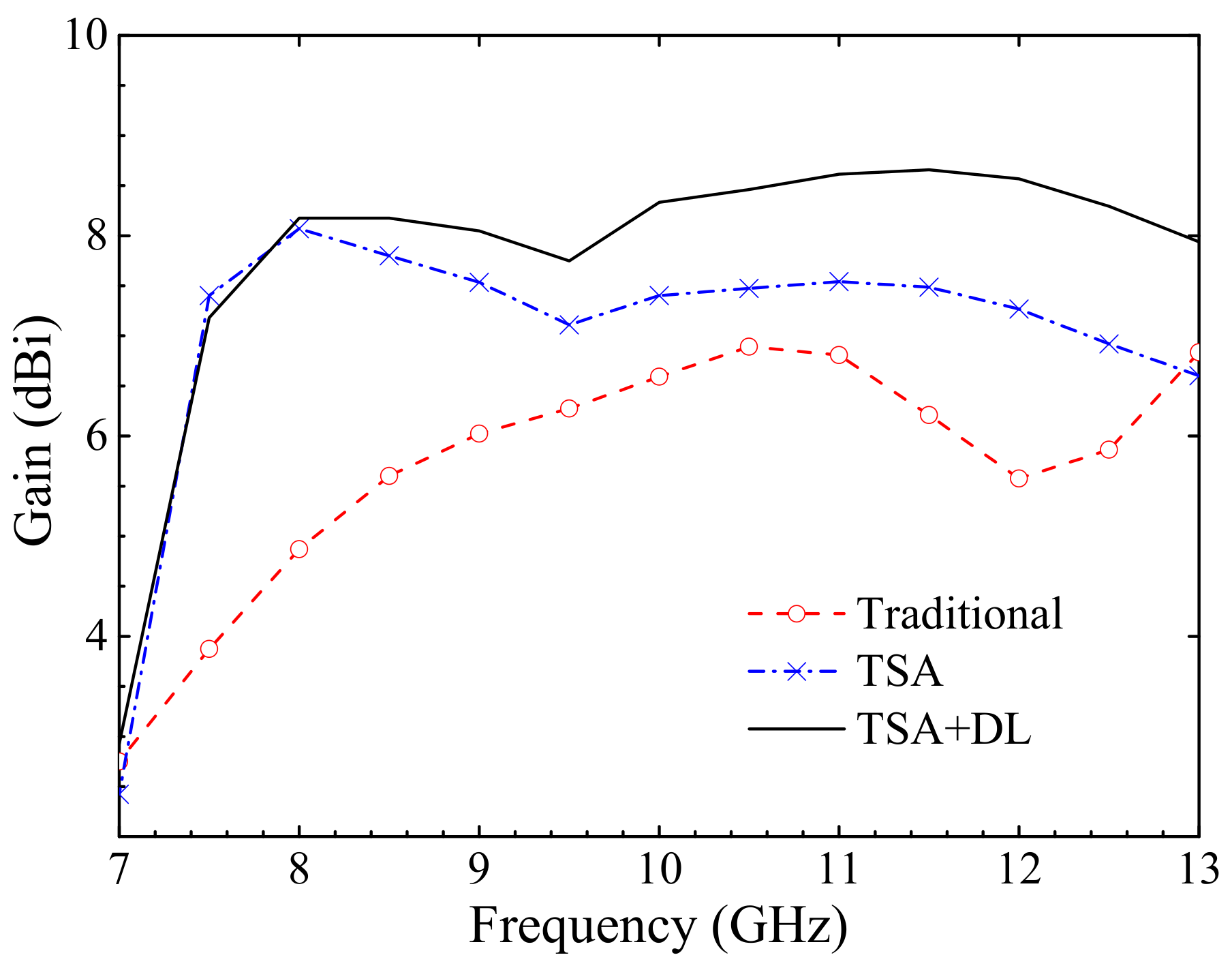

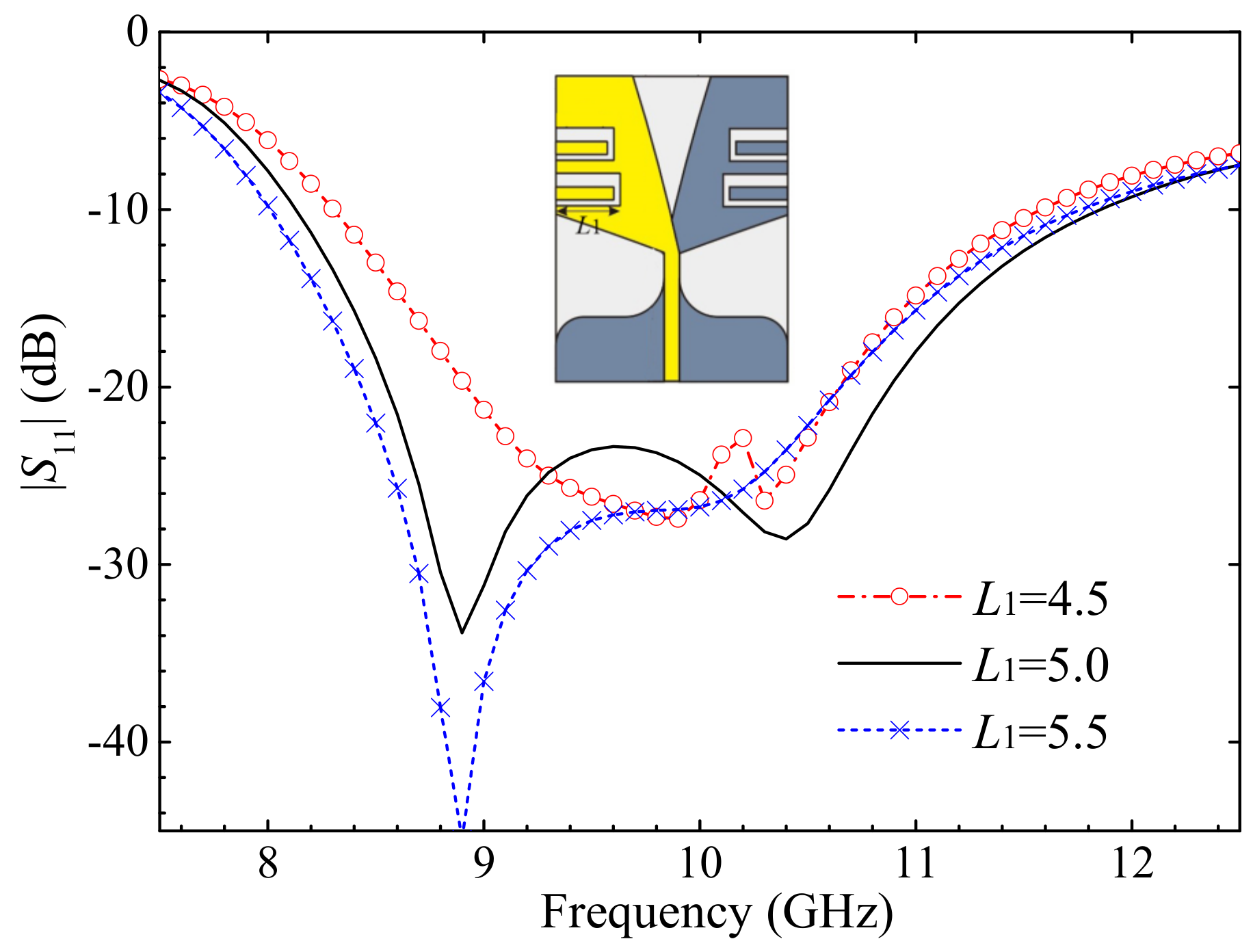
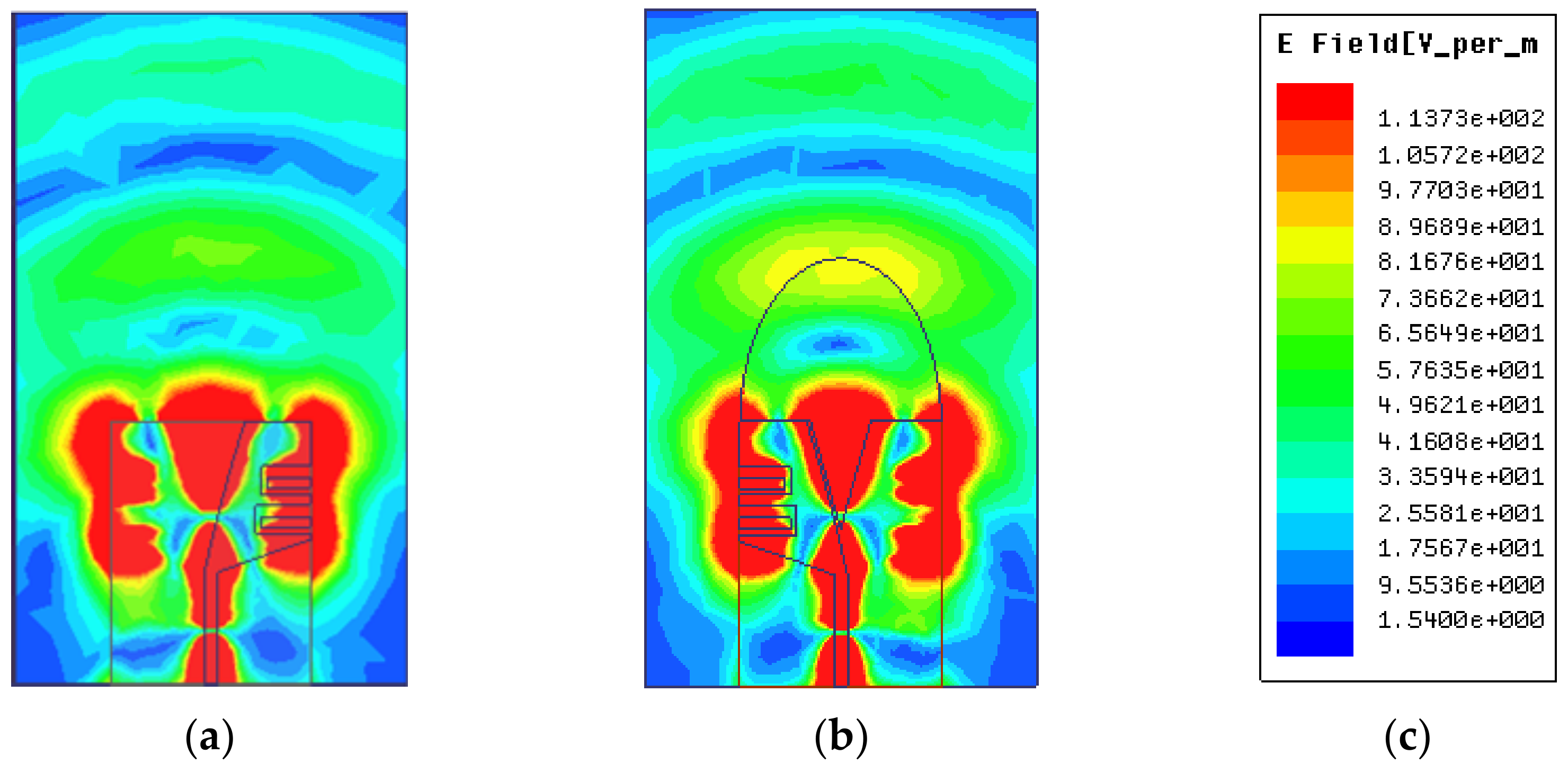
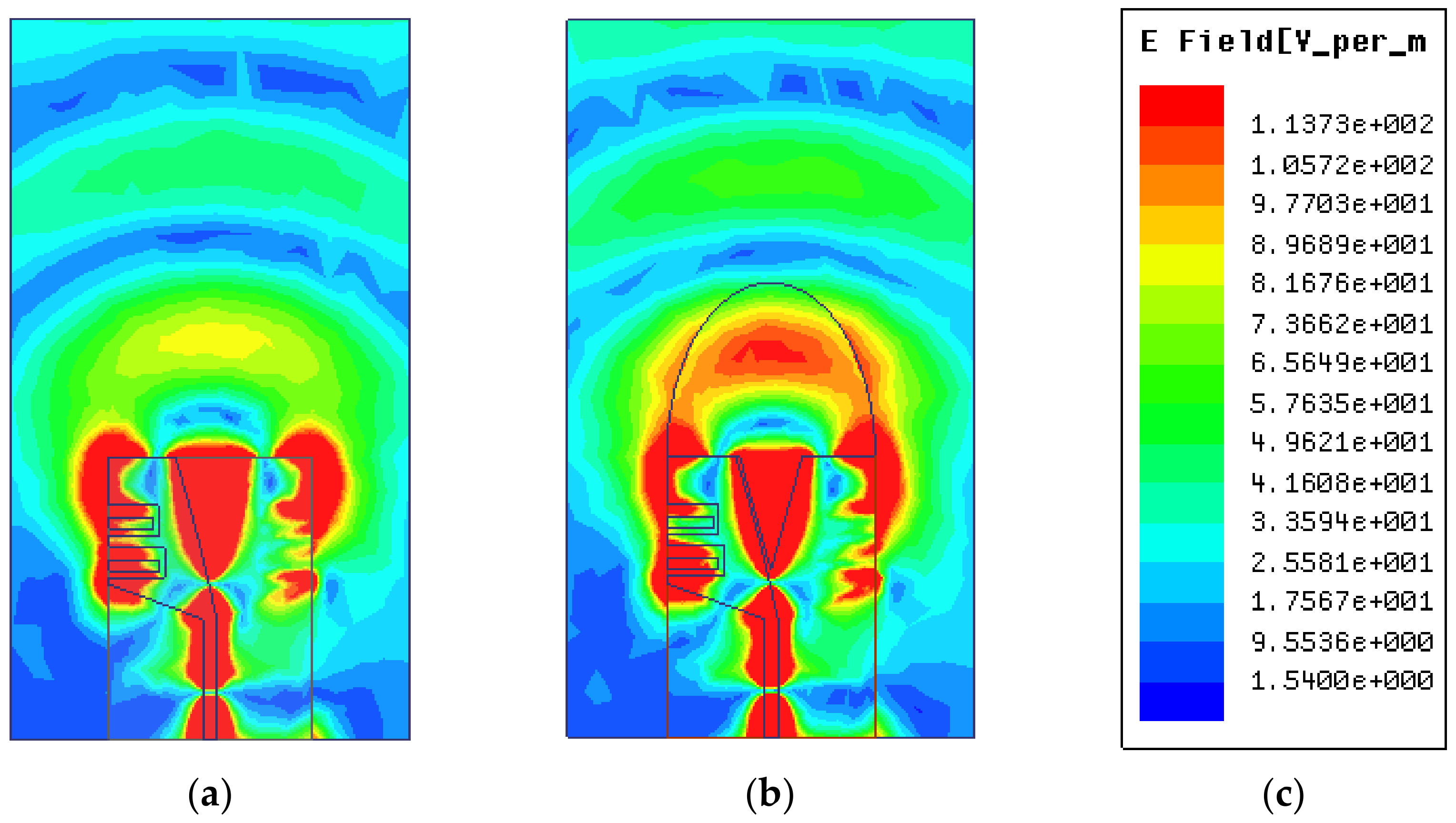
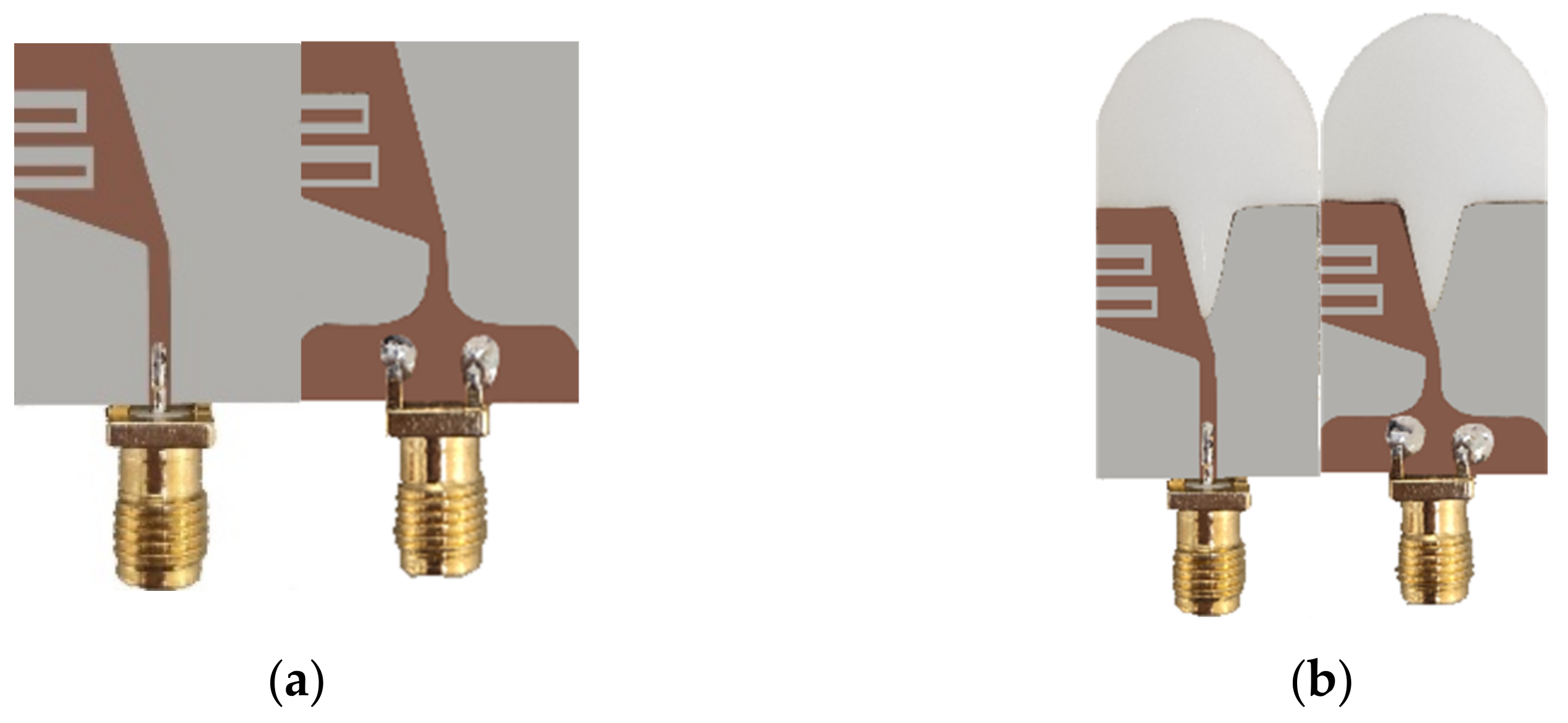
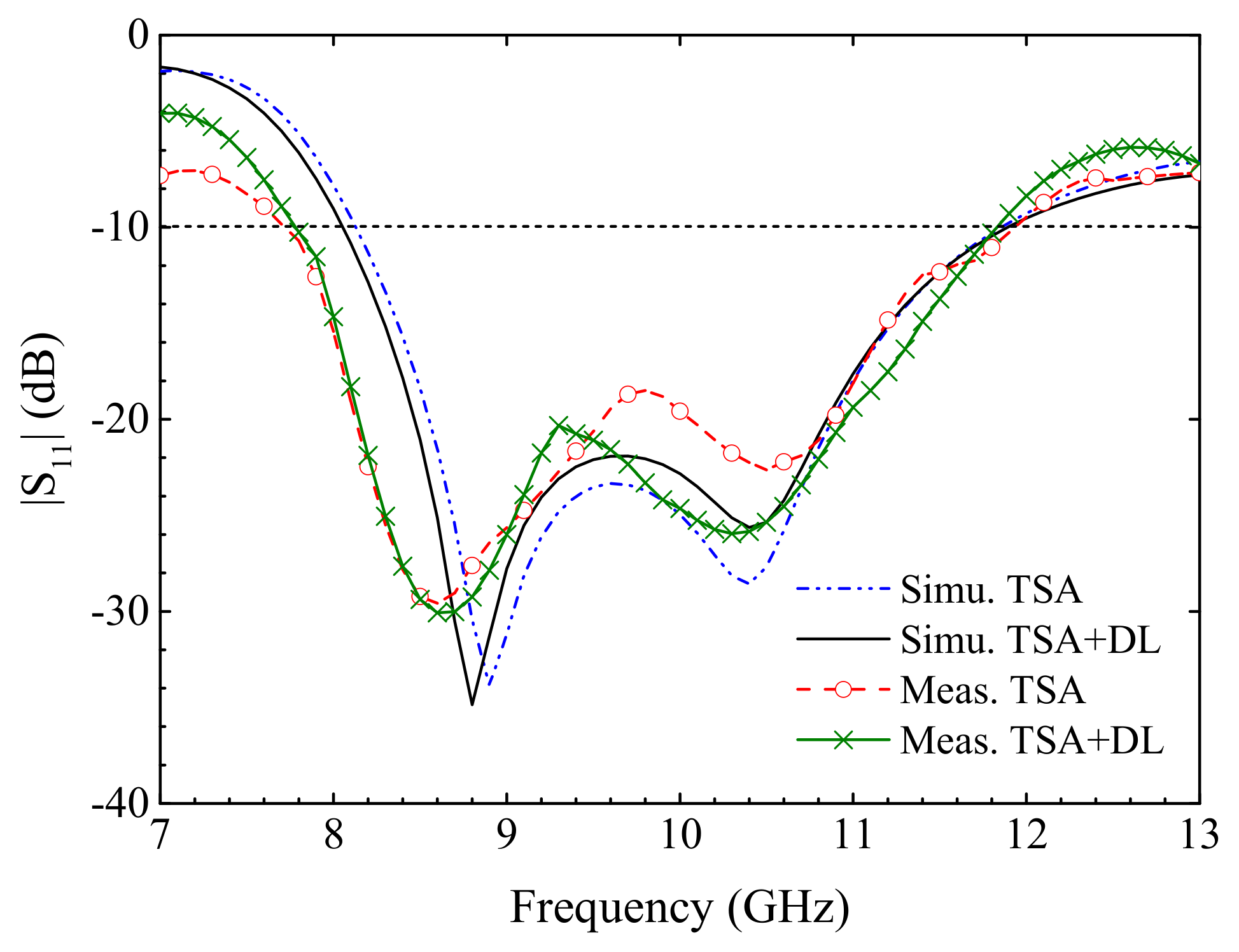
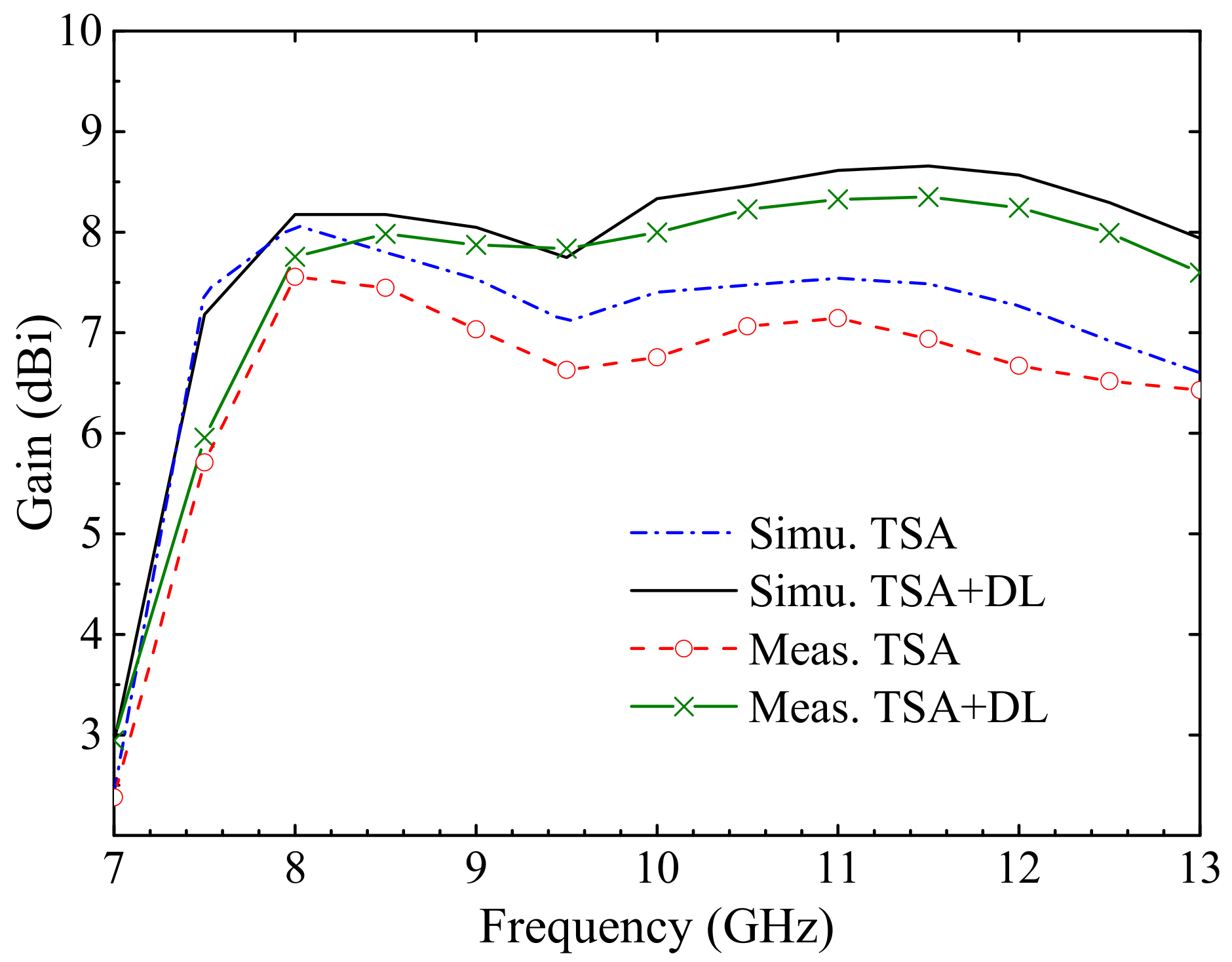
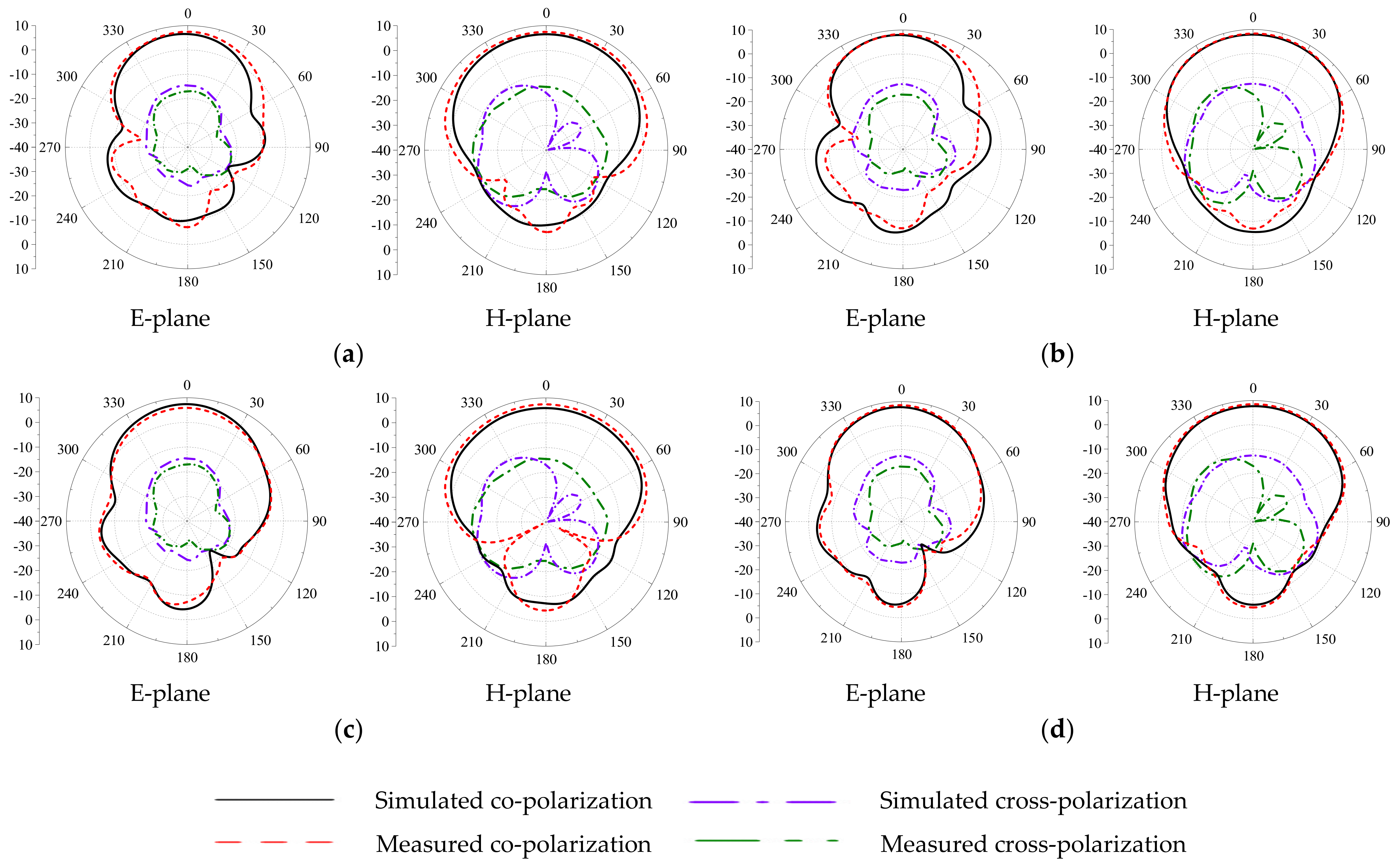

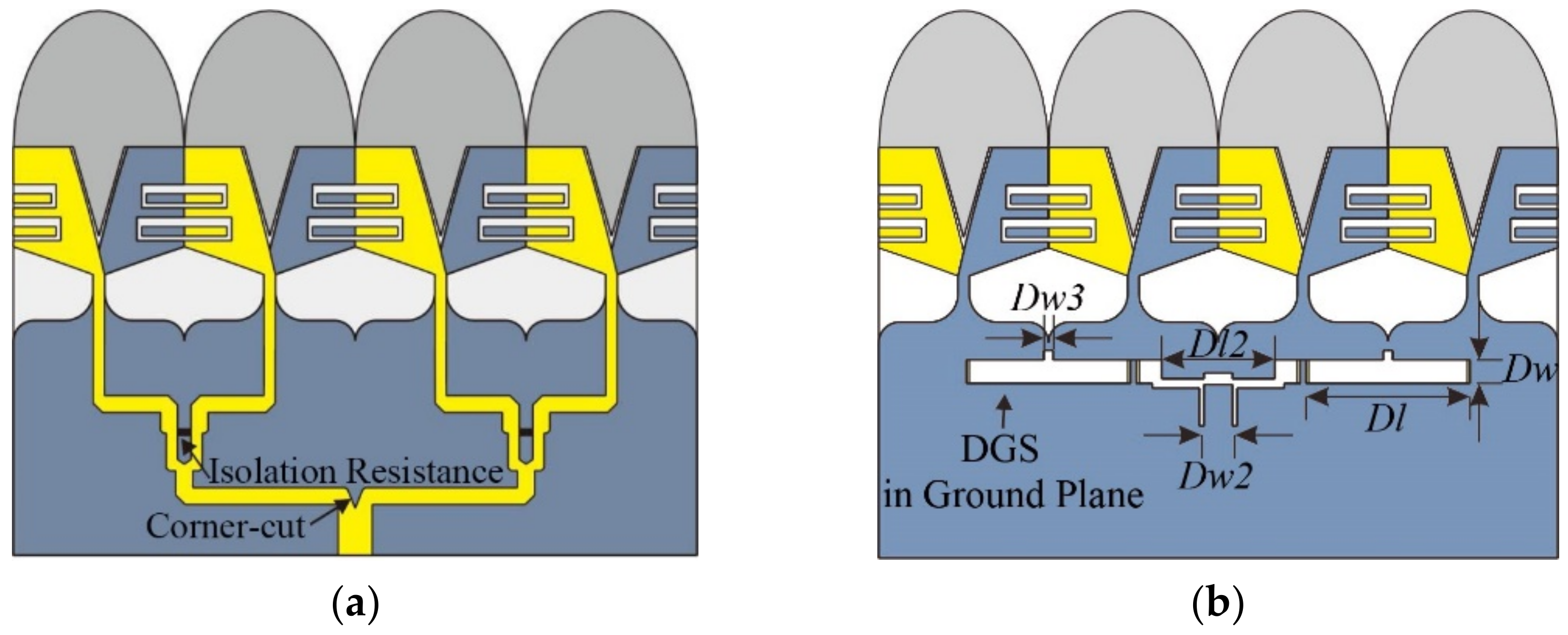




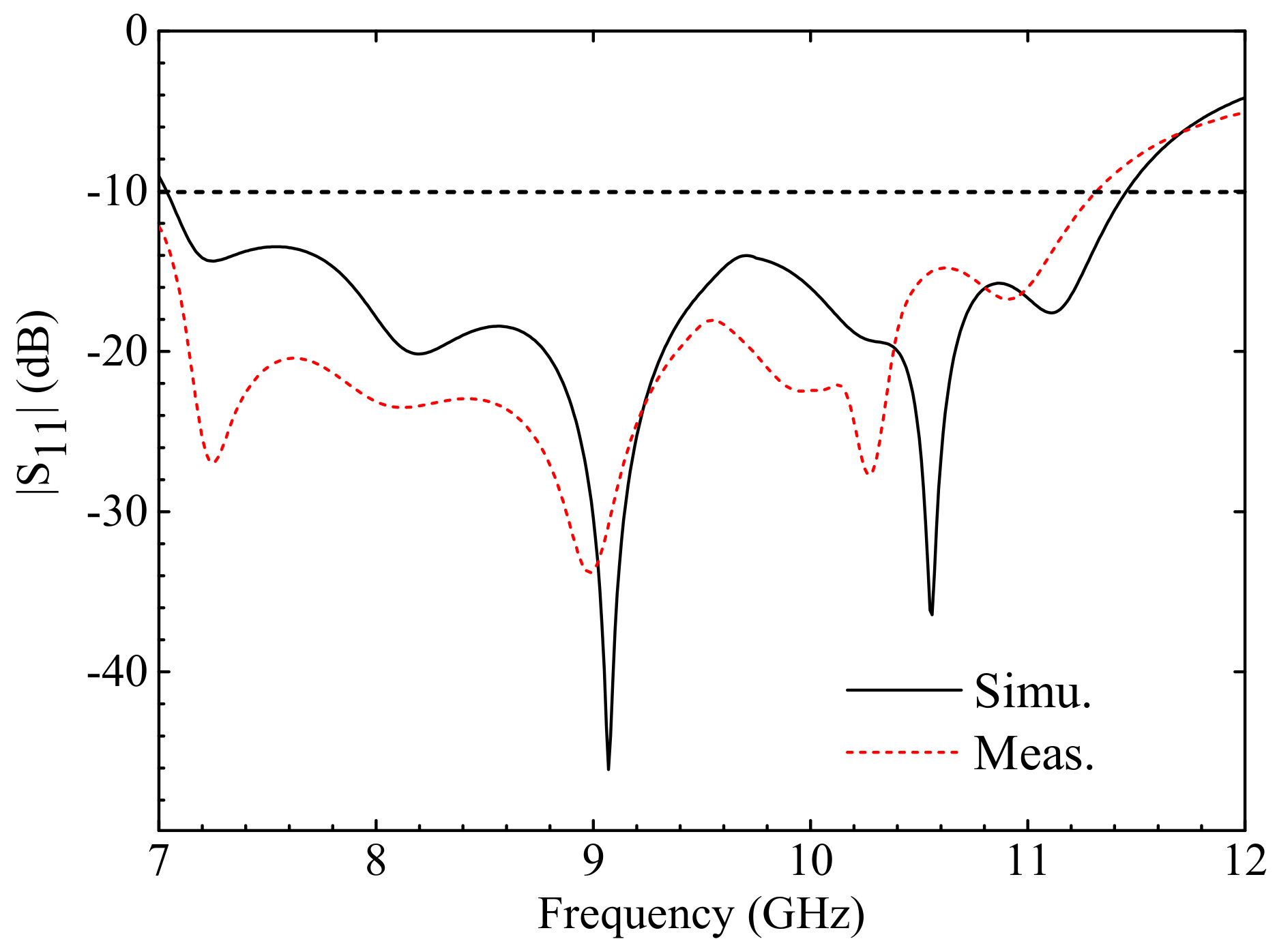



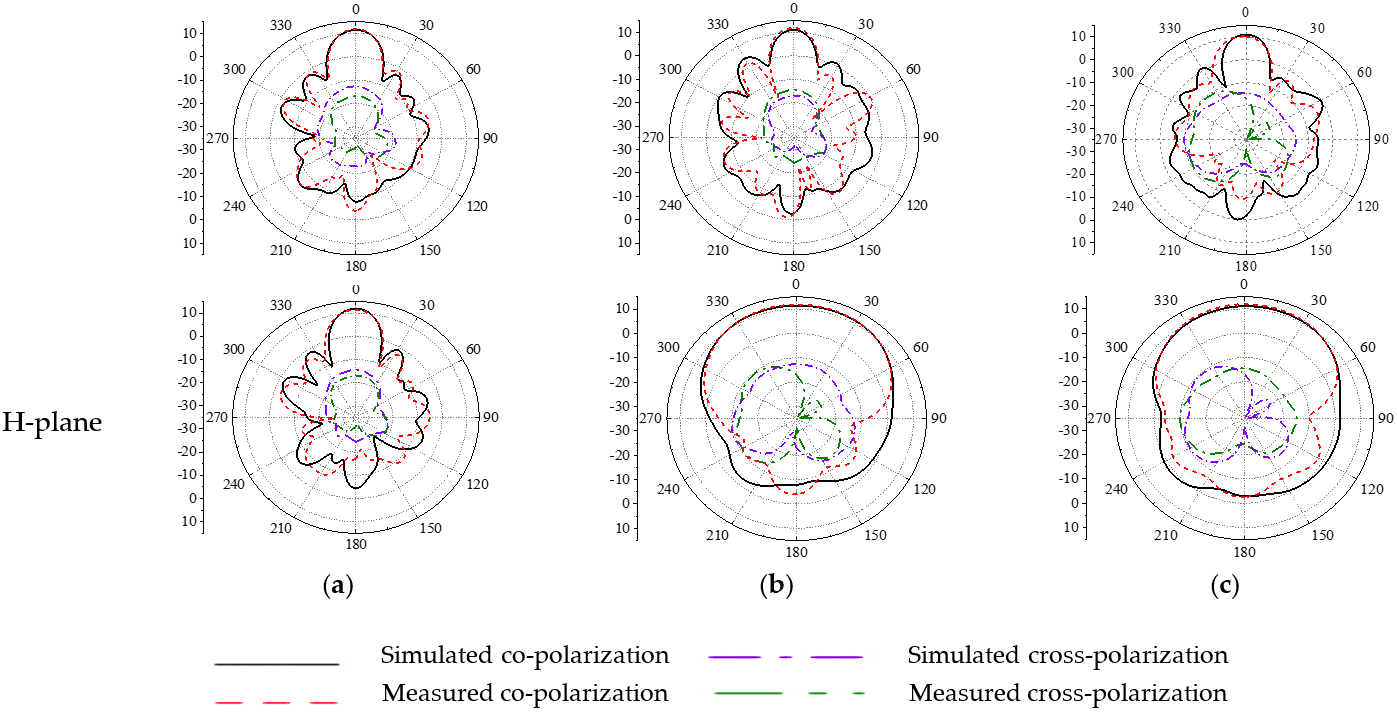
| Parameter | L | W | w | Wf | Yf | L1 |
|---|---|---|---|---|---|---|
| Size | 23.5 | 18 | 6 | 1.2 | 14 | 5 |
| Parameter | L2 | W1 | Ls | Ew | El | Eh |
| Size | 4.5 | 2.5 | 10.5 | 18 | 17 | 3 |
| Parameter | Dl | Dw | Dl2 | Dw2 | Dw3 |
|---|---|---|---|---|---|
| Size | 17.4 | 2 | 12 | 3 | 3 |
| Type | Frequency (GHz) | Bandwidth (%) | Gain (dBi) | |
|---|---|---|---|---|
| Simulated | Measured | |||
| Single antenna | 7.8–11.9 | 41.6 | 8.43 | 8.35 |
| Antenna array | 7–11.5 | 48.6 | 12.4 | 12.1 |
| Ref. | Performance Parameter Feed Type | Number of Elements | Bandwidth (GHz) | Size λ × λ × λ | Gain (dBi) |
|---|---|---|---|---|---|
| [17] | Microstrip Line | 8 | 24.6–28.5 (14.69%) | 6.22 × 2.99 × 0.08 | 11.3 |
| [18] | SIW | 4 | 70–103 (38.15%) | 9.4 × 3.5 × 0.12 | 19.1 |
| [19] | Microstrip Line | 8 | 24.75–27.5 (10.53%) | 4.71 × 7.45 × 0.04 | 12.9 |
| [20] | SIW | 4 | 38.9–44.5 (13.42%) | 4.56 × 4.52 × 0.036 | 14.9 |
| [21] | SIW | 8 | 8–12 (25%) | 4 × 3.6 × 0.32 | 16.5 |
| [23] | Microstrip Line | 8 | 24.8–28.5 (13.88%) | 6.22 × 2.99 × 0.08 | 11.2 |
| [24] | Microstrip Line | 4 | 2.26–2.54 (5.83%) | 1.44 × 0.48 × 0.096 | 10 |
| [25] | Microstrip Line | 8 | 5.22–5.64 (7.73%) | 1.8 × 1.4 × 0.0823 | 13.2 |
| This work | Microstrip Line | 4 | 7–11.2 (46.15%) | 1.43 × 2.40 × 0.03 | 12.1 |
Publisher’s Note: MDPI stays neutral with regard to jurisdictional claims in published maps and institutional affiliations. |
© 2021 by the authors. Licensee MDPI, Basel, Switzerland. This article is an open access article distributed under the terms and conditions of the Creative Commons Attribution (CC BY) license (https://creativecommons.org/licenses/by/4.0/).
Share and Cite
Wang, J.; Cui, W.; Zhou, Y.; Liu, R.; Wang, M.; Fan, C.; Zheng, H.; Li, E. Design of Wideband Antenna Array with Dielectric Lens and Defected Ground Structure. Electronics 2021, 10, 2066. https://doi.org/10.3390/electronics10172066
Wang J, Cui W, Zhou Y, Liu R, Wang M, Fan C, Zheng H, Li E. Design of Wideband Antenna Array with Dielectric Lens and Defected Ground Structure. Electronics. 2021; 10(17):2066. https://doi.org/10.3390/electronics10172066
Chicago/Turabian StyleWang, Jinhang, Wenjie Cui, Yang Zhou, Ruipeng Liu, Mengjun Wang, Chao Fan, Hongxing Zheng, and Erping Li. 2021. "Design of Wideband Antenna Array with Dielectric Lens and Defected Ground Structure" Electronics 10, no. 17: 2066. https://doi.org/10.3390/electronics10172066






